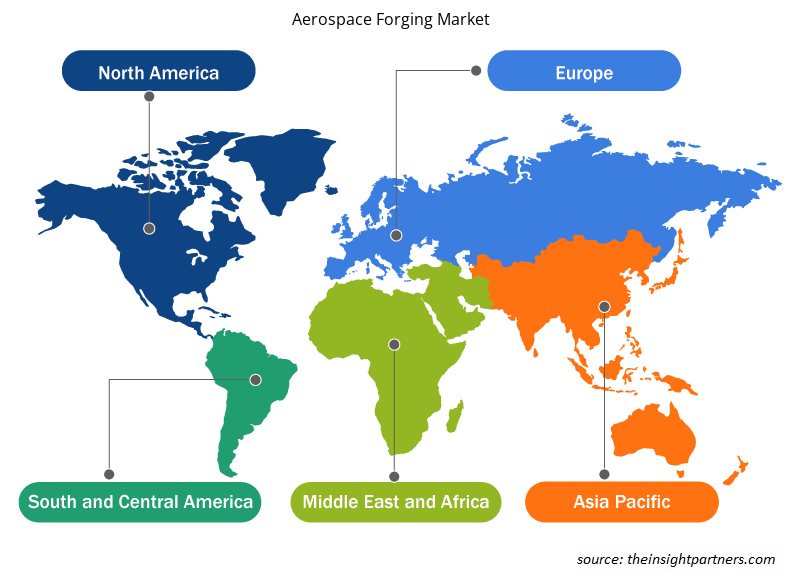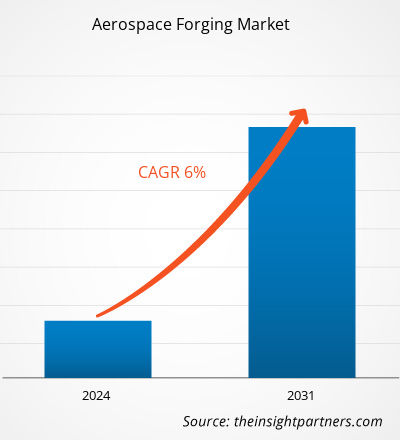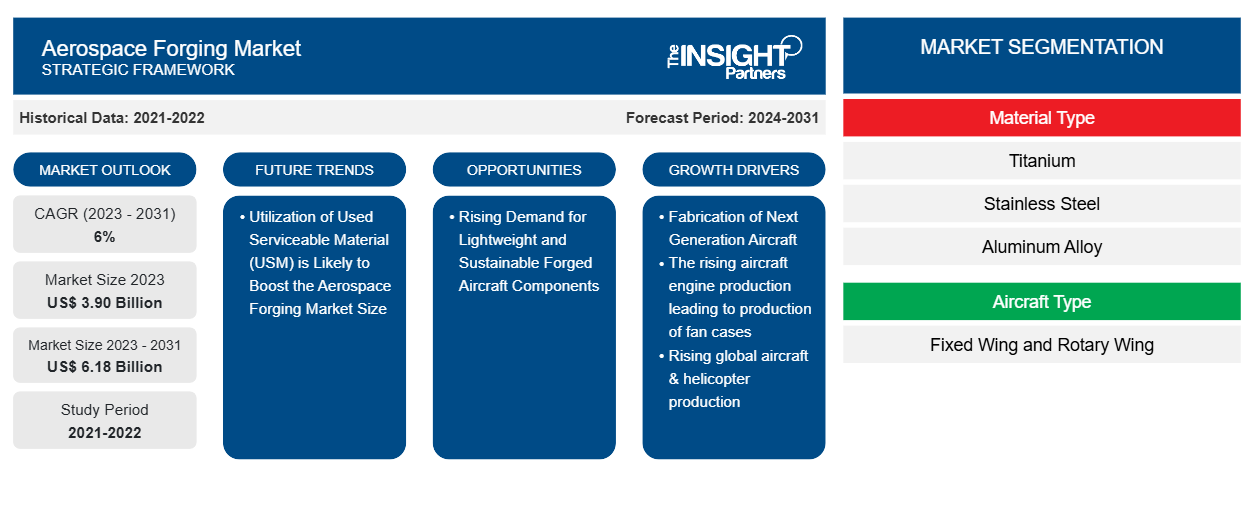Das Marktvolumen für Schmiedeprodukte für die Luft- und Raumfahrt soll von 3,90 Milliarden US-Dollar im Jahr 2023 auf 6,18 Milliarden US-Dollar im Jahr 2031 ansteigen. Für den Markt wird für den Zeitraum 2023–2031 eine durchschnittliche jährliche Wachstumsrate (CAGR) von 6,0 % erwartet.
Nordamerika beherbergt über 40 % der weltweiten Hubschrauberflotte und plant daher, die bestehende Flotte in den nächsten Jahren zu kaufen und durch eine neue zu ersetzen. Auf diese Weise ist die Region in der Lage, die Marktanforderungen der Luft- und Raumfahrt zu erfüllen. Der Ersatz bestehender Flotten durch neue Hubschrauber wird gleichzeitig auch den Markt für Luft- und Raumfahrtschmieden ankurbeln. Zu den Unternehmen, die Flugzeugtriebwerke und Schmiedeprodukte herstellen und liefern, gehören The Boeing Company, Patriot Forge Co., Scot Forge, United Technologies Corporation und andere.
Marktanalyse für Schmiedeteile für die Luft- und Raumfahrt
Der Markt für Schmiedeteile für die Luft- und Raumfahrt dürfte zwischen 2023 und 2031 stark wachsen. Diese Nachfrage nach Luft- und Raumfahrtfiltern wird hauptsächlich durch die Nachfrage nach Aluminium- und Titanlegierungen für die Herstellung verschiedener Flugzeugkomponenten wie Fangehäuse, Turbinenscheiben und Rotoren angetrieben. Darüber hinaus ist die steigende Zahl der produzierten Flugzeugtriebwerke ein weiterer wichtiger Faktor, der weltweit eine neue Nachfrage nach Schmiedeteilen für die Luft- und Raumfahrt erzeugt.
Marktübersicht für Schmiedeteile für die Luft- und Raumfahrt
Der Markt für Schmiedeteile für die Luft- und Raumfahrt wird zwischen 2023 und 2031 voraussichtlich ein starkes Wachstum aufweisen. Die Nachfrage auf dem Markt für Schmiedeteile für die Luft- und Raumfahrt wird hauptsächlich von einigen der unten genannten Faktoren getrieben:
- Die steigende Produktion von Flugzeugtriebwerken führte zur Herstellung von Lüftergehäusen
- Steigende weltweite Flugzeug- und Helikopterproduktion
- Bedarf aus MRO der bestehenden Flugzeugflotte
- Steigende Produktion von Militärflugzeugen
Diese Faktoren dürften zu einem gesunden Wachstum des Marktes für Schmiedeteile für die Luft- und Raumfahrt führen. Darüber hinaus hatten die USA im Jahr 2023 den größten Anteil am weltweiten Markt für Schmiedeteile für die Luft- und Raumfahrt. Das Land ist ein führender Hersteller von allgemeiner Luftfahrtausrüstung wie Kleinflugzeugen, Hubschraubern und Geschäftsflugzeugen. Die Luft- und Raumfahrtindustrie des Landes hat eine Verschiebung der Produktionsinvestitionen beobachtet. Das Land macht derzeit mehr als 35 % der weltweiten Flugzeugproduktion aus. Darüber hinaus haben einige der wichtigsten Flugzeughersteller, nämlich Boeing, Airbus, Bombardier und Textron Inc., ihre Produktionsstandorte in den USA. Diese renommierten Akteure unterstützen auch das Geschäft mit Schmiedeteilen für die Luft- und Raumfahrt, da der Bedarf an Schmiedeteilen für die Luft- und Raumfahrt mit einem Anstieg der Flugzeugproduktion steigt. Precision Metal Product Inc., Scot Forge, Fountaintown Forge, Pacific Forge Incorporated, Arconic Inc. und Mettis Aerospace Inc. sind einige der bedeutenden Akteure auf dem US-amerikanischen Markt für Schmiedeteile für die Luft- und Raumfahrt.
Passen Sie diesen Bericht Ihren Anforderungen an
Sie erhalten kostenlos individuelle Anpassungen an jedem Bericht, einschließlich Teilen dieses Berichts oder einer Analyse auf Länderebene, eines Excel-Datenpakets sowie tolle Angebote und Rabatte für Start-ups und Universitäten.
- Holen Sie sich die wichtigsten Markttrends aus diesem Bericht.Dieses KOSTENLOSE Beispiel umfasst eine Datenanalyse von Markttrends bis hin zu Schätzungen und Prognosen.
Treiber und Chancen auf dem Markt für Schmiedeprodukte für die Luft- und Raumfahrt
Herstellung von Flugzeugen der nächsten Generation
In der kommerziellen Luft- und Raumfahrtindustrie wird die Produktion von Schmalrumpf- und Großraumflugzeugen sowie von Strahltriebwerken der nächsten Generation voraussichtlich ein Boomfaktor sein. Das Strahltriebwerk der nächsten Generation verwendet fortschrittliche Metallpulverlegierungen und Superlegierungen auf Nickelbasis. Es ist ein wirtschaftliches Modell des Flugzeugs, das dazu beiträgt, die Kraftstoffeffizienz und Leistung eines Flugzeugs zu verbessern. So haben beispielsweise Airbus und Boeing einen Auftrag zur Herstellung von mehr als 40.000 Flugzeugen erhalten. Die Produktion massiver Flugzeuge der nächsten Generation wird den Markt für Luft- und Raumfahrtkomponenten letztendlich vergrößern. Darüber hinaus wird die Produktion von Flugzeugen der nächsten Generation voraussichtlich auch den Unternehmen, die Luft- und Raumfahrtkomponenten schmieden, reichlich Wachstumsaussichten bieten.
Die Verwendung von gebrauchtem, gebrauchsfähigem Material (USM) dürfte den Markt für Schmiedeteile für die Luft- und Raumfahrt vergrößern
Mit der kontinuierlichen Zunahme des Flugverkehrs steigt die Zahl der Flugzeuge erheblich an, um die steigende Nachfrage der Verbraucher zu erfüllen. Derzeit werden jedoch jedes Jahr fast 400 bis 600 Verkehrsflugzeuge ausgemustert, altern und zerlegt, was zu einem großen Abfallberg führt. Diese enorme Abfallmenge umfasst etwa 1000 Tonnen Kohlefaser, 1800 Tonnen Legierungen, 30000 Tonnen Aluminium und 600 Tonnen andere Schrottmaterialien. Im Zusammenhang mit dem zunehmenden Umweltbewusstsein haben Luft- und Raumfahrtunternehmen wie Pratt & Whitney zusammen mit Regierungsstellen neue Wege gefunden, um die Rohstoffe für die Herstellung von Luft- und Raumfahrtteilen durch recycelte und erneuerbare Materialien zu ersetzen.
Nach Angaben der Internationalen Zivilluftfahrt-Organisation (ICAO) wird aufgrund des steigenden Flugverkehrs in den nächsten 10 bis 15 Jahren die Lebensdauer von fast 18.000 Flugzeugen erwartet. Die Verwendung recycelter Materialien dürfte daher enorme Chancen für Schmiedeunternehmen in der Luft- und Raumfahrtbranche bieten. So haben beispielsweise Boeing und Bharat Forge Ltd. Interesse an einem Einstieg in den USM-Markt bekundet. Darüber hinaus bietet das Recyclinggeschäft in Nord- und Südamerika und Europa sowohl Flugzeugherstellern als auch Schmiedeunternehmen in der Luft- und Raumfahrtbranche enorme Chancen. Allerdings hat jedes Land seine eigenen Geschäftsbedingungen in Bezug auf die jeweilige Branche und ihre Aktivitäten. So hatte Europa beispielsweise früher Schwierigkeiten, Titan zu kaufen oder zu recyceln. Um diese Situation zu beseitigen, ist EcoTitanium die erste Anlage, die Titanlegierungen in Flugzeugqualität recycelt. Diese Anlage verwendet hochmoderne Öfen zum Recycling von Titan und senkt gleichzeitig die Emissionswerte.
Segmentierungsanalyse des Marktberichts für Schmiedeteile für die Luft- und Raumfahrt
Wichtige Segmente, die zur Ableitung der Marktanalyse für Schmiedeteile für die Luft- und Raumfahrt beigetragen haben, sind Materialtyp, Flugzeugtyp, Anwendung und Geografie.
- Basierend auf dem Materialtyp wurde der Markt für Schmiedeteile für die Luft- und Raumfahrt in Titan, Edelstahl, Aluminiumlegierungen und andere unterteilt. Das Segment der Aluminiumlegierungen hatte im Jahr 2023 einen größeren Marktanteil.
- Nach Flugzeugtyp wurde der Markt in Starrflügel- und Drehflügler segmentiert. Das Segment der Starrflügelflugzeuge hatte im Jahr 2023 den größten Marktanteil.
- In Bezug auf die Anwendung wurde der Markt in Rotoren, Turbinenscheiben, Wellen, Lüftergehäuse und andere segmentiert. Das Segment der Turbinenscheiben dominierte den Markt im Jahr 2023.
Analyse der Marktanteile von Schmiedeprodukten für die Luft- und Raumfahrt nach geografischen Gesichtspunkten
Der geografische Umfang des Berichts zum Markt für Schmiedeprodukte für die Luft- und Raumfahrt ist hauptsächlich in fünf Regionen unterteilt: Nordamerika, Europa, Asien-Pazifik, Naher Osten und Afrika sowie Südamerika.
Im Jahr 2023 war Nordamerika die dominierende Region auf dem globalen Markt für Schmiedeteile für die Luft- und Raumfahrt. Dies liegt daran, dass die Region stark von Schmiedeunternehmen für die Luft- und Raumfahrt geprägt ist. Die Region beherbergt mehrere etablierte Flugzeughersteller, Hersteller von Flugzeugtriebwerken und andere Hersteller von Flugzeugkomponenten. Diese Hersteller von Flugzeugen/Flugzeugzellen und Flugzeugkomponenten verlangen geschmiedete Produkte, um die Effizienz der Triebwerke, Fahrwerke, Flugzeugstrukturen und letztlich des gesamten Flugzeugs zu steigern. Aus diesem Grund verzeichnet die Region ein Wachstum bei mehreren Akteuren, die erhebliche Umsatzanteile beitragen. Diese Faktoren haben dazu geführt, dass die nordamerikanische Region den globalen Markt für Schmiedeteile für die Luft- und Raumfahrt dominiert.
Nachrichten und aktuelle Entwicklungen zum Schmiedemarkt für die Luft- und Raumfahrt
Der Markt für Schmiedeteile für die Luft- und Raumfahrt wird durch die Erhebung qualitativer und quantitativer Daten nach Primär- und Sekundärforschung bewertet, die wichtige Unternehmensveröffentlichungen, Verbandsdaten und Datenbanken umfasst. Im Folgenden finden Sie eine Liste der Entwicklungen auf dem Markt für Schmiedeteile für die Luft- und Raumfahrt und deren Strategien:
- Im November 2023 unterzeichnete Safran Aircraft Engines eine Absichtserklärung mit Hindustan Aeronautics Limited, um eine industrielle Zusammenarbeit bei der Herstellung von Schmiedeteilen für Triebwerke für Verkehrsflugzeuge zu entwickeln. (Quelle: Safran Group, Pressemitteilung/Unternehmenswebsite/Newsletter)
- Im Februar 2021 unterzeichneten HAL und GE Aviation einen Vertrag im Wert von 12 Millionen US-Dollar für die Entwicklung von Ringschmiedeteilen, darunter Abdeckungen, Gehäuse, Ringe und Dichtungen aus Stahl und Nickelschmiedeteilen. (Quelle: GE Aviation, Pressemitteilung/Unternehmenswebsite/Newsletter)
Regionale Einblicke in den Markt für Schmiedeprodukte für die Luft- und Raumfahrt
Die regionalen Trends und Faktoren, die den Markt für Schmiedeteile für die Luft- und Raumfahrt im Prognosezeitraum beeinflussen, wurden von den Analysten von Insight Partners ausführlich erläutert. In diesem Abschnitt werden auch die Marktsegmente und die Geografie des Marktes für Schmiedeteile für die Luft- und Raumfahrt in Nordamerika, Europa, im asiatisch-pazifischen Raum, im Nahen Osten und Afrika sowie in Süd- und Mittelamerika erörtert.

- Erhalten Sie regionale Daten zum Markt für Schmiedeteile für die Luft- und Raumfahrt
Umfang des Marktberichts für Schmiedeteile für die Luft- und Raumfahrt
| Berichtsattribut | Details |
|---|---|
| Marktgröße im Jahr 2023 | 3,90 Milliarden US-Dollar |
| Marktgröße bis 2031 | 6,18 Milliarden US-Dollar |
| Globale CAGR (2023 - 2031) | 6 % |
| Historische Daten | 2021-2022 |
| Prognosezeitraum | 2024–2031 |
| Abgedeckte Segmente | Nach Materialtyp
|
| Abgedeckte Regionen und Länder | Nordamerika
|
| Marktführer und wichtige Unternehmensprofile |
|
Dichte der Marktteilnehmer im Luft- und Raumfahrtsektor: Auswirkungen auf die Geschäftsdynamik verstehen
Der Markt für Schmiedeteile für die Luft- und Raumfahrt wächst rasant. Dies wird durch die steigende Nachfrage der Endnutzer aufgrund von Faktoren wie sich entwickelnden Verbraucherpräferenzen, technologischen Fortschritten und einem größeren Bewusstsein für die Vorteile des Produkts vorangetrieben. Mit der steigenden Nachfrage erweitern Unternehmen ihr Angebot, entwickeln Innovationen, um die Bedürfnisse der Verbraucher zu erfüllen, und nutzen neue Trends, was das Marktwachstum weiter ankurbelt.
Die Marktteilnehmerdichte bezieht sich auf die Verteilung der Firmen oder Unternehmen, die in einem bestimmten Markt oder einer bestimmten Branche tätig sind. Sie gibt an, wie viele Wettbewerber (Marktteilnehmer) in einem bestimmten Marktraum im Verhältnis zu seiner Größe oder seinem gesamten Marktwert präsent sind.
Die wichtigsten auf dem Markt für Schmiedeteile für die Luft- und Raumfahrt tätigen Unternehmen sind:
- Arconic GmbH
- Alle Metalle und Schmieden Gruppe
- Bharat Forge Limited
- Consolidated Industries, Inc
- Farinia-Gruppe
- Fountaintown Forge, Inc
Haftungsausschluss : Die oben aufgeführten Unternehmen sind nicht in einer bestimmten Reihenfolge aufgeführt.

- Überblick über die wichtigsten Akteure auf dem Markt für Schmiedeteile für die Luft- und Raumfahrt
Marktbericht zum Schmieden in der Luft- und Raumfahrt
Der Bericht „Marktgröße und Prognose für Schmiedeprodukte in der Luft- und Raumfahrt (2021–2031)“ bietet eine detaillierte Analyse des Marktes, die die folgenden Bereiche abdeckt:
- Marktgröße und Prognose auf globaler, regionaler und Länderebene für alle wichtigen Marktsegmente, die im Rahmen des Projekts abgedeckt sind
- Marktdynamik wie Treiber, Beschränkungen und wichtige Chancen
- Wichtige Zukunftstrends
- Detaillierte Porter's Five Forces Analyse
- Globale und regionale Marktanalyse mit wichtigen Markttrends, wichtigen Akteuren, Vorschriften und aktuellen Marktentwicklungen
- Branchenlandschaft und Wettbewerbsanalyse, einschließlich Marktkonzentration, Heatmap-Analyse, prominenten Akteuren und aktuellen Entwicklungen
- Detaillierte Firmenprofile mit SWOT-Analyse
- Historische Analyse (2 Jahre), Basisjahr, Prognose (7 Jahre) mit CAGR
- PEST- und SWOT-Analyse
- Marktgröße Wert/Volumen – Global, Regional, Land
- Branchen- und Wettbewerbslandschaft
- Excel-Datensatz
Aktuelle Berichte
Erfahrungsberichte
Grund zum Kauf
- Fundierte Entscheidungsfindung
- Marktdynamik verstehen
- Wettbewerbsanalyse
- Kundeneinblicke
- Marktprognosen
- Risikominimierung
- Strategische Planung
- Investitionsbegründung
- Identifizierung neuer Märkte
- Verbesserung von Marketingstrategien
- Steigerung der Betriebseffizienz
- Anpassung an regulatorische Trends























 Kostenlose Probe anfordern für - Markt für Schmiedeteile für die Luft- und Raumfahrt
Kostenlose Probe anfordern für - Markt für Schmiedeteile für die Luft- und Raumfahrt